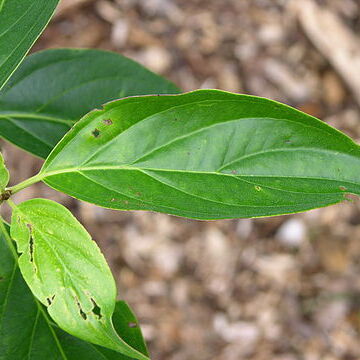Trees 5–18 m tall, rarely to 40 m tall. Bark gray or greenish gray, rectangularly splitting. Young branches grayish green, ± 4-angled, pubescent with grayish short appressed trichomes; old branches brown, glabrous, with brown, narrowly elliptic lenticels. Leaves opposite; petiole 0.8–2 cm; leaf blade abaxially grayish green, elliptic or ovate-elliptic, 6–12 × 2–5.5 cm, papery, abaxially densely pubescent with white short appressed trichomes and papillae, scabrous, veins 3 or 4, base cuneate to broadly cuneate, margin slightly revolute, apex shortly acuminate to acuminate. Paniculate to corymbose cymes 6–10 cm wide, with short white trichomes. Flowers white, ca. 7 mm in diam. Calyx lobes triangular, 0.4–0.5 mm, longer than disk. Petals narrowly lanceolate, 3.5–5 × 0.9–1.3 mm. Stamens 6–6.8 mm, equaling petals; anthers yellow, narrowly oblong. Style cylindrical, sometimes slightly expanded near apex, 3.5–4 mm; stigma disciform, not broader than style. Fruit purplish black or black, globose, 6–7 mm in diam.; stones globose, 4–4.5 mm in diam., ribs inconspicuous. Fl. May, fr. Sep–Nov.
More
A shrub or small tree. It loses its leaves during the year. It grows 5-18 m high. The bark is smooth. The leaves are opposite and narrowly oval. They are 3-9 cm long by 2-6 cm wide. They taper to the tip. The leaves have fine hairs. The flowers are white and 9 mm across. They are in groups at the ends of branches. The fruit is fleshy and bluish-black. They are round and 6 mm across.


